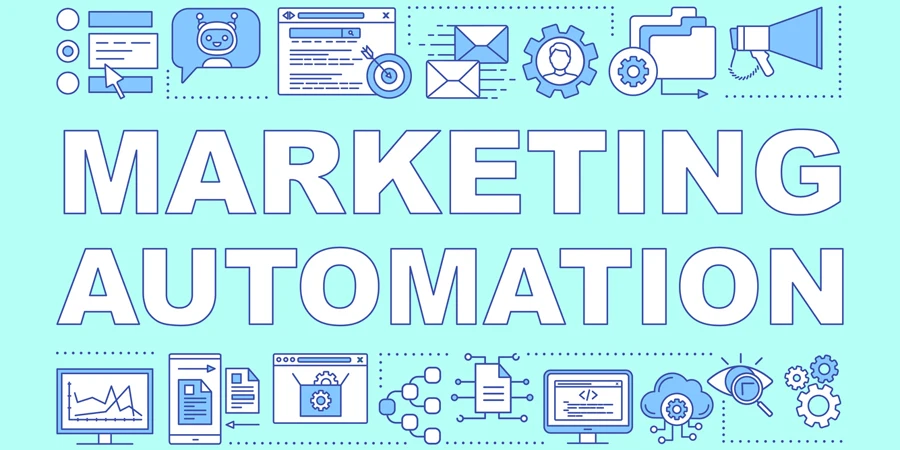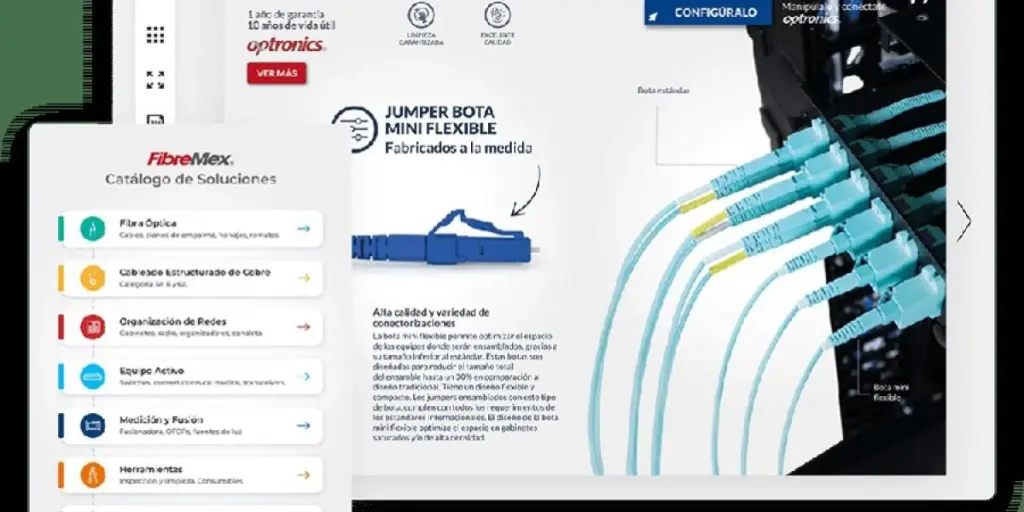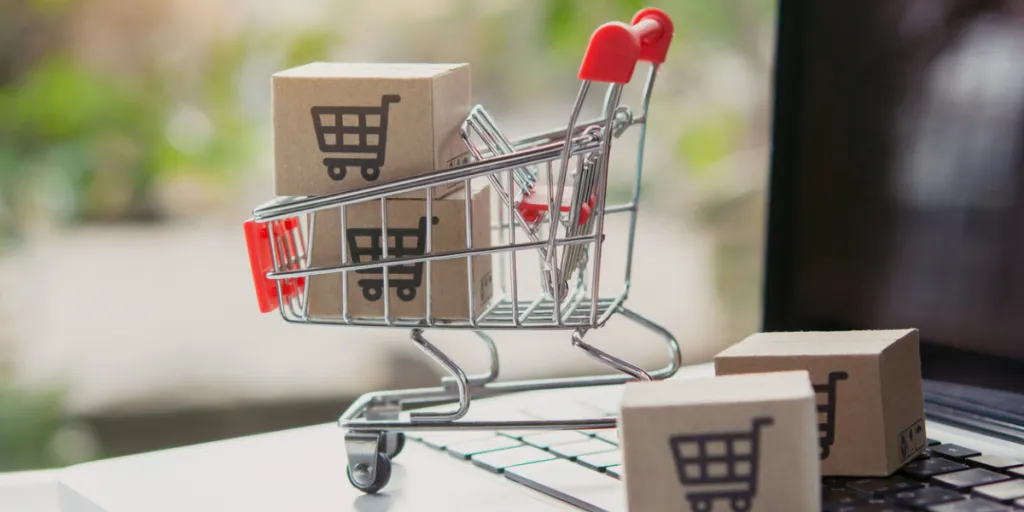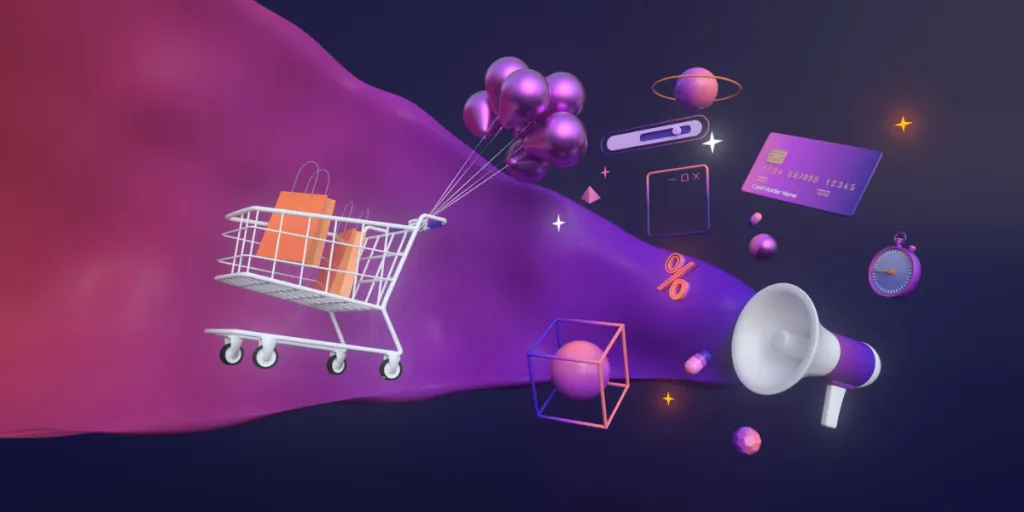Table of Contents
1. What is marketing automation?
2. Benefits of marketing automation
3. Types of marketing automation
4. Marketing automation for different business sizes
5. How to use marketing automation
6. Marketing automation integration
7. Marketing automation and AI (Chatbots)
8. Marketing automation best practices
9. Marketing automation examples
10. Conclusion
Marketing automation revolutionized the way businesses reach and engage with customers. It involves the use of technology to automate and streamline repetitive business tasks. By automating workflows and interactions, you can deliver timely messages to customers consistently, while you’re focused on other tasks.
The benefits of marketing automation are undeniable — it can improve efficiency, ensure consistent onboarding for every subscriber or customer, boost lead generation, and drive sales growth.
This comprehensive guide will tell you everything you need to know about marketing automation. We’ll explore its functionalities, types, benefits, and how to use it to enhance your marketing campaigns.
What is marketing automation?
Marketing automation refers to the use of specialized automation software to automate marketing tasks and workflows. It involves automating repetitive tasks, such as email marketing, social media posting, ad campaigns, and customer interactions.
Omnisend, for instance, allows you to set up different types of email automation workflows like welcome email, abandoned cart, order confirmation, and more for communication with customers through email and SMS.
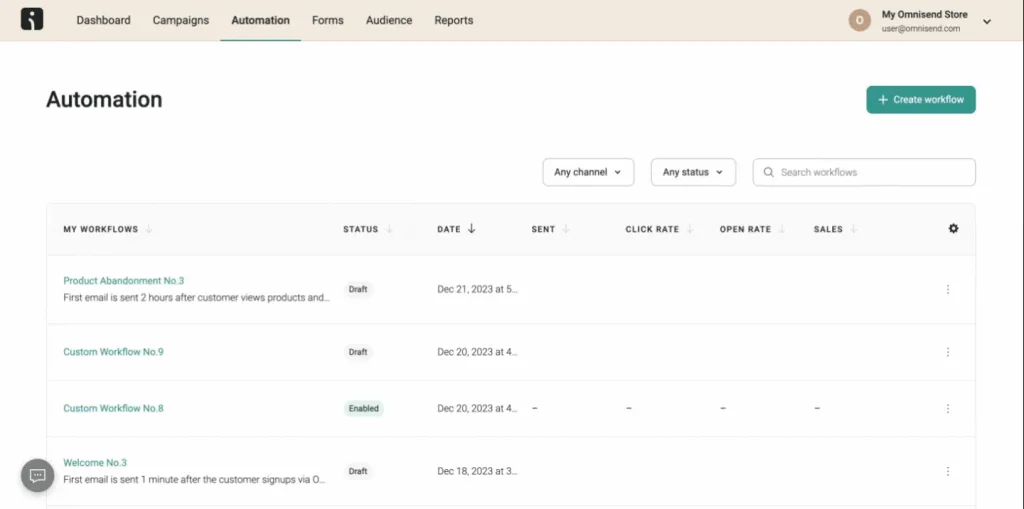
In essence, automation in marketing helps you streamline your workflows and make the process more efficient. Automation allows you to save time and perform marketing tasks with precision and consistency.
How does marketing automation work?
The marketing automation process involves creating workflows for your marketing campaigns that work on autopilot based on the actions taken by the user or other triggers.
You begin by collecting customer data from website visits, social media, email interaction, and so on. Using this data, you build a profile of each customer and create targeted segments.
Next, you use automation to target each segment with specific messages at specific times, based on certain triggers.
For example, this welcome email automation workflow is set to begin when a subscriber fills out a signup form.
This triggers a welcome message sent to the subscriber via email, SMS, or push notification to offer a 10% discount on their first order.
The workflow involves multiple steps and continues until the subscriber places an order and exits the workflow.
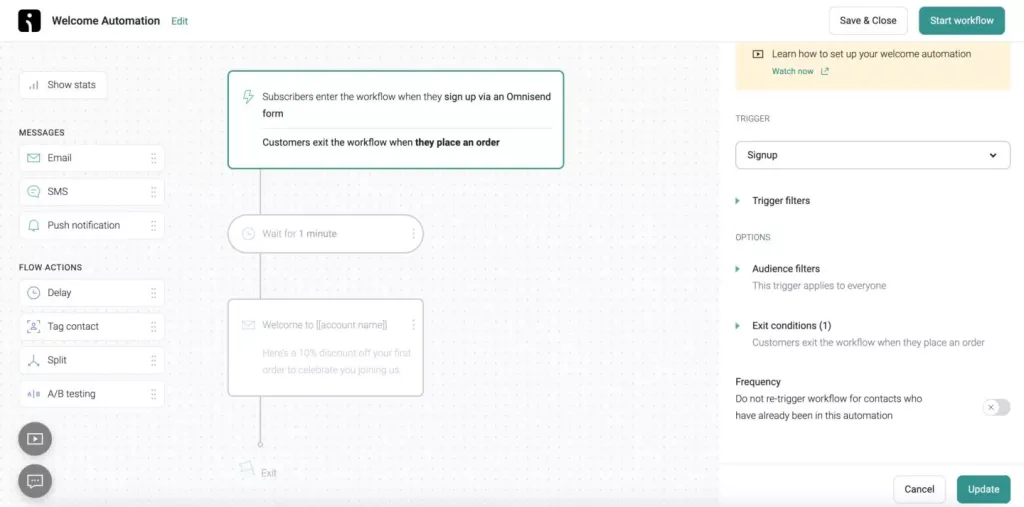
Benefits of marketing automation
Automation in marketing offers several advantages that can streamline business operations and outcomes. Here are some of the key benefits of marketing automation for your business.
Increased efficiency and productivity
Successful marketing involves numerous tasks and processes, and even a small mistake may have lasting consequences.
Automation eliminates the risk of manual error and ensures consistency and accuracy in repetitive tasks.
This also reduces the workload on your marketing team, freeing them up to use their resources and time for more productive tasks.
Improved customer personalization and engagement
With CRM marketing automation, you can collect and analyze customer data to tailor your marketing efforts.
Automation can help you use this data to create customer segments and share targeted messages with each segment.
Though this can be done manually, automation scales the process of ecommerce personalization. This, in turn, helps you deliver exceptional customer experiences and boost engagement.
Enhanced lead generation and nurturing
Automating lead generation processes can streamline the process of capturing and nurturing leads. By setting up automated workflows, you can create a structured system for managing your lead pipeline without the need for constant manual intervention.
Moreover, automated lead nurturing campaigns can engage prospects with personalized messages throughout their journey. This engages and nurtures leads until they are ready to buy.
One example of an automated workflow for lead generation is the use of gated offers, such as demos, free trials, ebooks, and more.
When a potential customer expresses interest in the gated offer by filling out the signup form, they are automatically added to the business’s email list. This triggers the start of an automated lead-nurturing drip-email campaign.
Boosted sales conversion rates
Marketing automation can help you identify and prioritize the most promising leads and boost your ecommerce sales conversions.
By automating lead scoring, you can ensure that your resources are directed toward nurturing the most promising leads.
With timely and personalized communication, you can move prospects through the sales funnel faster. This improves sales conversion rates and creates a more efficient sales process.
Measurable results and data-driven decision-making
Automation can streamline data collection from various sources, which aids in designing targeted marketing campaigns.
Marketing tools that offer automation and analytics features can help you identify patterns, trends, and areas for improvement. This will enable you to make informed decisions and improve your marketing strategy.
Types of marketing automation
Automation is useful in optimizing all kinds of marketing strategies. Here are some types of marketing automation that are most commonly used.
Email marketing automation
By automating email marketing, you can maintain consistent communication with your audience and engage them.
Email marketing automation platforms help you create automated drip email workflows to guide leads through a sales funnel.
Omnisend’s 2024 marketing report shows that automated messages can be highly effective in driving conversions. Some of the most successful campaign types are back-in-stock notifications (at 5.8%), welcome messages (3.7%), and cart abandonment messages (2.7%).
Automated emails are typically triggered by specific customer actions, though there can be other triggers.
In the automation workflow below, a customer triggers a workflow by filling out a signup form.
The workflow includes emails sent after an hour, the next day, and three days after the signup:
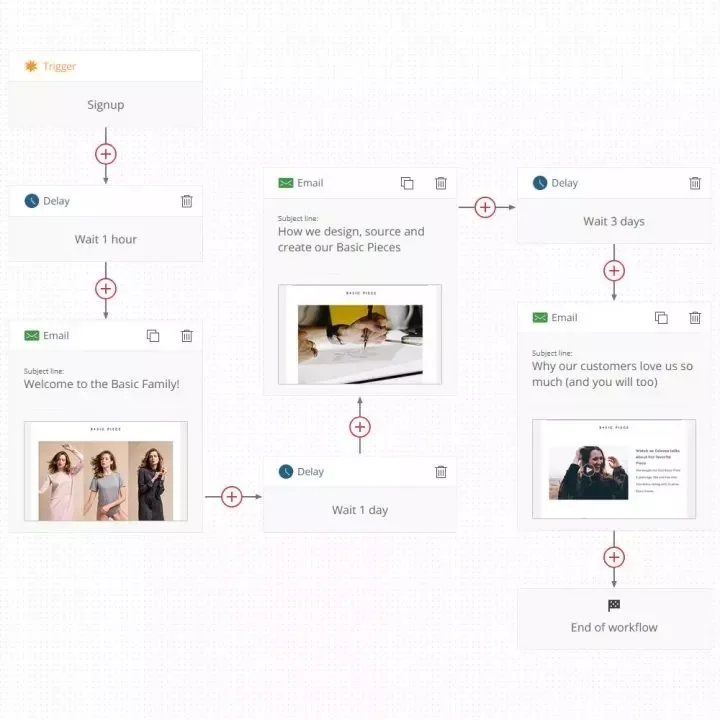
Social media marketing automation
Managing many social media accounts can be overwhelming, but automation can make the process easier.
Using automated scheduling tools, you can set times and dates for publishing content on various platforms. This helps you post frequently and keep up with your editorial calendar without requiring manual effort.
Some tools also let you set up automated responses to comments and messages. This ensures prompt response to customer comments and higher customer satisfaction.
Lead nurturing automation
By creating automated workflows, you can engage and nurture leads with targeted messaging.
This can involve various channels, including email, SMS, and more. You can even create different types of lead nurturing funnels for different types of leads.
For instance, the workflow for someone who signs up for your newsletter would be different from that for someone who abandons their cart.
Marketing campaign automation
You can automate your marketing activities across channels to get the best results.
For instance, you can schedule email sequences, SMS messages, social media posts, and other marketing materials to be delivered automatically based on specific triggers.
The goal is to maintain consistent messaging and customer experience across various channels.
Analytics and reporting automation
This involves automating performance tracking and reporting tasks. Analytics tools with automation capabilities allow you to set up periodic reports and even send alerts when a new report is ready.
You can also set up automated alerts to flag significant changes in your campaign performance metrics. This allows you to promptly respond and take corrective measures if needed.
Marketing automation for different business sizes
Businesses of all sizes can streamline their marketing efforts with automation. However, the marketing automation goals, strategies, and tools would vary based on the size and growth stage of a business.
Let’s discuss some automation tools for small and large businesses and how you should choose the right one for your business.
Small business
Small businesses often have limited resources and budgets. As such, marketing automation for small businesses should involve cost-effective and easy-to-use tools.
Some popular small business marketing automation tools include:
- Omnisend
- Mailchimp
- HubSpot
- Zapier
These tools often come with pre-built templates that make it easy to set up automation workflows.
Enterprise solutions
Large enterprises need more sophisticated solutions. You need tools that can handle high volumes, and provide advanced automation features.
As an enterprise, the following marketing automation platforms can be useful:
- Salesforce Marketing Cloud
- Marketo
- Pardot
- Omnisend
- Eloqua
These tools offer advanced features, such as personalization, robust analytics, and multi-channel integration. They can handle large contact lists and complex segmentation for enterprise marketing automation.
Choosing the right tool
Here’s a step-by-step process you can follow when choosing marketing automation software for your business.
- Identify your needs: Define your business requirements and marketing objectives
- Evaluate key features: Compare the features offered by various tools and see if they align with your requirements
- Consider user experience: Prefer a platform with an intuitive user interface that your team can easily use
- Assess scalability: Select a software solution capable of scaling alongside your business and its evolving needs
How to use marketing automation
Getting started with marketing automation can have its challenges. However, a well-planned strategy can help simplify this process.
Here’s a practical roadmap for getting started with marketing automation:
- Define your marketing goals and target audience: The first step in using marketing automation is to define your marketing goals. What do you want to achieve with your marketing efforts? Some common goals include spreading brand awareness, generating more leads, or increasing sales and revenue. Your automated workflow will be in line with your marketing goals.
- Choose a suitable marketing automation platform: There are many marketing automation platforms, each with its own features and capabilities. Research and compare different options to select the one that best fits your needs.
- Build segmented email lists and create targeted campaigns: Segment your email lists based on various factors, such as demographics, interests, and behavior. Then, create tailored campaigns that target different market segments, based on their needs and preferences.
- Set up automated workflows and triggers based on customer behavior: Map out workflows that guide customers through their buyer’s journey. Define the sequence of actions and timing for each step and set up triggers to activate workflows based on customer behavior.
- Track and analyze results to optimize performance: Track and analyze your campaign performance metrics to identify what’s working and what needs improvement. Then, refine your workflow to maximize results.
Marketing automation integration
Integrating email marketing automation tools with your existing tech stack can help you maximize the benefits. Let’s explore the three prominent integrations you should consider:
CRM integration
Customer relationship management systems collect, organize, and analyze customer data, making them a must-have for any business.
Integrate your marketing tools with CRM systems like Salesforce, Zoho, Capsule, and more to sync customer data.
This ensures your marketing automation tool uses the most relevant customer information to keep your marketing campaigns effective.
Data management
The success of email marketing automation greatly relies on data management.
When you integrate your marketing tools with data management systems like SAP, Tableau, and others, you can streamline data collection from various touchpoints and its management.
This integration lets you maintain a centralized repository of data, ensuring that it’s accurate, up-to-date, and easily accessible.
Third-party integrations
You can integrate your email marketing tools with various third-party platforms to boost their capabilities. Some common integrations include Zapier, ClickFunnels, and Unbounce for lead generation
As your business grows, your marketing needs become more complex. Third-party integrations can help you add new capabilities to accommodate this growth without disrupting existing processes.
Marketing automation and AI (Chatbots)
When you combine marketing automation and AI, the results can be phenomenal. AI-powered chatbots are extremely effective in simulating human conversation to engage and convert leads into customers.
AI chatbots can handle complex queries and guide customers through the buying processes. They interact with users in real time, providing instant responses and personalized communication.
Here are some of the ways AI chatbots revolutionize marketing automation:
- 24/7 customer support: AI chatbots can provide round-the-clock customer support. This enhances customer satisfaction as they get quick help for any issue, without waiting for a human agent.
- Lead qualification: Chatbots can help with lead qualification and nurturing. Since they engage with potential customers, chatbots can gather important customer data. Your marketing team can then use this data to qualify leads and create relevant automated workflows for lead nurturing.
- Personalized website experience: AI tools like chatbots can help guide site visitors to the right pages or provide helpful product recommendations. This helps personalize their on-site experience while making site navigation easier.
Marketing automation best practices
To maximize the benefits of automation, consider incorporating the following marketing automation best practices:
- Mapping out customer journey: Create detailed customer journey maps to understand how customers interact with your brand across various touchpoints. Identify key stages and align marketing automation to engage customers at each stage.
- Setting up lead scoring: Develop a lead scoring model to prioritize leads based on their engagement level and likelihood to convert. Use automation tools to assign scores to leads and ensure your sales team focuses on the most qualified leads.
- Automating internal processes: Don’t limit yourself to only marketing campaign automation. You can also automate internal processes like data entry, reporting, and more to streamline your operations.
- Implementing product event marketing automation: Product events like launches, updates, or promotions can benefit from automation. Use triggers to send targeted messages before, during, and after the event. This can ensure timely communication and maximize the impact.
- Updating and maintaining customer database: Regularly clean and update your contact database. Accurate data ensures that your automation campaigns reach the right audience.
- Automating across channels: While email is a common starting point for marketing automation, ensure your automation strategy works across channels to maintain consistent messaging and tracking.
- Continuously analyzing and optimizing: Regularly review the performance of your marketing campaigns. Then, you can make adjustments to your automated workflow as needed.
Marketing automation examples
Let’s explore some real-life marketing automation examples to inspire your next campaign.
Welcome email
This automated email workflow is triggered when a new customer signs up for a company’s newsletter or joins their online community. The goal is to welcome the new subscriber and initiate conversation.
This welcome email by Bleame is a good example. After joining the brand’s community, the user receives this welcome note with a special discount.
It contains multiple CTA buttons and based on the recipient’s actions, the next set of automated emails will be initiated.

Triggered product recommendations
This email is triggered by customer actions like website searches or product views. Trigger emails with product recommendations are sent to provide customers with more options to choose from.
For example, this email by Warby Parker recommends products to a user who browsed its website but didn’t buy anything. It’s fun and engaging as it recommends products by sun signs, helping the user narrow down their options.

Personalized birthday offers
Businesses send automated text messages or emails to wish customers a happy birthday. These are triggered by date and are easy to set up as many businesses have their customers’ birthdays on record.
See the example below by Applebees. This personalized email with a birthday gift code is perfect for making anyone’s day special:

Conclusion
Marketing automation has transformed how businesses engage with their audiences.
By automating marketing processes and interactions, businesses of all sizes can ensure timely and personalized communication with their customers.
This can boost lead generation, and drive sales growth.
Source from Omnisend
Disclaimer: The information set forth above is provided by omnisend.com independently of Alibaba.com. Alibaba.com makes no representation and warranties as to the quality and reliability of the seller and products.
